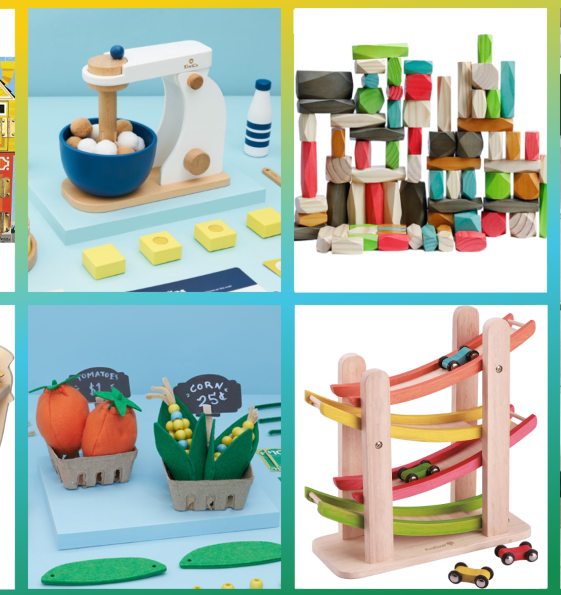The world of toys has evolved significantly over the decades, transitioning from simple, traditional playthings to sophisticated smart toys equipped with the latest technology. This evolution presents a unique opportunity to bridge the generational gap between parents who grew up with traditional toys and their children who are now engaging with smart, interactive play.
By integrating Montessori toys for 2 year olds into this balanced approach, parents can provide a rich and varied developmental experience for their children. This article explores how traditional and smart toys can complement each other, offering a holistic approach to early childhood education.
The Evolution of Toys
Traditional toys have long been cherished for their simplicity and educational value. From wooden blocks and dolls to puzzles and board games, these toys have played a crucial role in child development by promoting creativity, imagination, and social skills. With the advent of smart toys, the landscape of play has changed dramatically. These modern toys incorporate advanced features like connectivity, artificial intelligence, and interactive learning, providing new and exciting ways to engage children.
Benefits of Traditional Toys
- Hands-On Learning: Traditional toys offer tactile and sensory experiences that are essential for developing fine motor skills and hand-eye coordination. For example, building blocks and puzzles require children to use their hands, enhancing their physical dexterity.
- Creativity and Imagination: Toys like dolls, action figures, and playsets encourage imaginative play, allowing children to create their own stories and scenarios. This type of play fosters creativity and problem-solving skills.
- Social Skills: Many traditional toys promote cooperative play and social interaction. Board games, for instance, teach children about taking turns, following rules, and working together, which are important social skills.
Advantages of Smart Toys
- Interactive Learning: Smart toys are designed to engage children through interactive features such as touchscreens, voice recognition, and motion sensors. These toys can teach various subjects, from basic math and literacy to coding and problem-solving.
- Adaptability: One of the key benefits of smart toys is their ability to adapt to a child’s learning pace and preferences. Through algorithms and AI, these toys can personalize the learning experience, providing challenges that are neither too easy nor too difficult.
- Engagement: The gamification aspects of smart toys, including rewards and progress tracking, keep children motivated and interested. This engagement can lead to more sustained and effective learning.
Integrating Traditional and Smart Toys
To provide a well-rounded play experience, it is important to blend traditional and smart toys. Here are some strategies for parents and educators:
- Balancing Technology and Hands-On Activities: Ensure that children have ample opportunities for both tech-based and physical play. For example, after a session with an educational app, encourage a break with building blocks or art supplies.
- Moderation and Supervised Play: Set boundaries on screen time and be actively involved in your child’s play. Supervision ensures that children use smart toys effectively and that their playtime remains balanced.
- Toy Rotation: Use a rotation system to keep the play environment fresh and engaging. Regularly switch out toys to maintain interest and encourage exploration.
Designing a Playroom for Both Worlds
Creating a playroom that integrates both traditional and smart toys can enhance the overall play experience. Here are some tips:
- Defined Zones: Set up different areas for tech-based and hands-on play. For instance, designate one corner for smart toys and another for traditional toys like blocks and puzzles.
- Safety and Accessibility: Ensure that the playroom is safe and child-friendly. Keep all toys within easy reach and organize them in a way that encourages independent play.
- Incorporating Learning Stations: Create interactive stations that promote exploration and discovery. For example, a reading nook with interactive storybooks or a science corner with educational robots.
Parental Involvement and Supervision
Parents play a crucial role in guiding their children’s play and ensuring a balanced approach. Here are some tips for effective parental involvement:
- Engage in Play: Actively participate in your child’s playtime. Ask questions, join in their activities, and provide guidance to enhance their learning experience.
- Set Boundaries: Establish clear rules for screen time and ensure that children have a variety of play experiences. Encourage playing outdoor toys, creative activities, and social interaction alongside smart toy use.
- Monitor Progress: Keep track of your child’s developmental milestones and adjust the play environment as needed. Pay attention to how different toys impact their learning and growth.
Success Stories and Real-Life Examples
Parents and educators who have successfully integrated both traditional and smart toys into their routines often see significant benefits. For example, one parent reported that their child developed strong problem-solving skills and creativity through a combination of building blocks and educational apps. An educator noted that students were more engaged and motivated when interactive storybooks and traditional puzzles were used together in the classroom.
Conclusion
Integrating traditional and smart toys offers a balanced and enriching approach to early childhood education. By combining the best of both worlds, parents and educators can provide a dynamic and engaging play environment that supports the holistic development of young children. Embracing this approach can help bridge the generational gap, fostering a love of learning and exploration in today’s tech-savvy youngsters.




